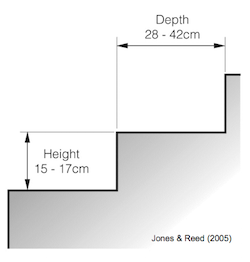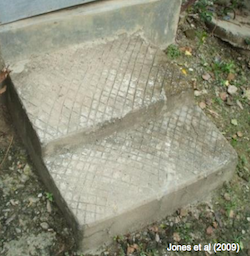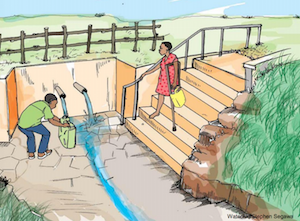Difference between revisions of "Accessible - Steps"
From Akvopedia
(Published from sandbox) |
(Published from sandbox) |
||
| Line 1: | Line 1: | ||
{| | {| | ||
| − | |||
| − | |style="vertical-align:top"|[[Image:steps2.png|thumb|left|220px|]] | + | |style="vertical-align:top"|[[Image:steps2.png|thumb|left|220px|Steps should be low and even – all the same height and depth]] |
| − | |style="vertical-align:top"|[[Image:steps3.png|thumb|left|220px|]] | + | |style="vertical-align:top"|[[Image:steps3.png|thumb|left|220px|Low concrete steps with cross-hatching to reduce the risk of slipping]] |
| + | |||
| + | |style="vertical-align:top"|[[Image:steps1.png|thumb|left|300px|Handrail accompanying steps to a protected spring]] | ||
|} | |} | ||
| Line 20: | Line 21: | ||
|width="20%"|'''Cost / labour'''<br> | |width="20%"|'''Cost / labour'''<br> | ||
|- | |- | ||
| − | |style="background-color: #EDEDED;"|Recommended step dimensions (for reference) | + | |style="background-color: #EDEDED;"|Recommended step dimensions (for reference)<br> |
| − | |Many users can manage low, even steps, especially when a handrail is provided. | + | '''Steps should be low and even – all the same height and depth''' |
| + | | | ||
| + | * Many users can manage low, even steps, especially when a handrail is provided. | ||
| + | * Steps take up less space than a ramp. | ||
|Steps exclude some users, e.g. those using mobility devices. | |Steps exclude some users, e.g. those using mobility devices. | ||
|Paint steps white or bright colour to increase visibility. | |Paint steps white or bright colour to increase visibility. | ||
| | | | ||
|- | |- | ||
| − | |style="background-color: #EDEDED;"| | + | |style="background-color: #EDEDED;"|'''Low concrete steps with cross-hatching to reduce the risk of slipping''' |
| − | |||
| − | |||
| − | |||
| − | |||
| − | |||
| − | |||
|Cross-hatching is easy to apply – the concrete is scored while wet | |Cross-hatching is easy to apply – the concrete is scored while wet | ||
|No edge protection for unstable or visually impaired users | |No edge protection for unstable or visually impaired users | ||
| Line 40: | Line 38: | ||
|Low | |Low | ||
|- | |- | ||
| − | |style="background-color: #EDEDED;"|Handrail accompanying steps to a protected spring | + | |style="background-color: #EDEDED;"|'''Handrail accompanying steps to a protected spring''' |
| | | | ||
* Useful for all users | * Useful for all users | ||
| Line 51: | Line 49: | ||
===Acknowledgements=== | ===Acknowledgements=== | ||
| − | * Content and images: [http://www.wateraid.org/what-we-do/our-approach/research-and-publications/view-publication?id=aff6d098-00f2-42e5-b9a0-22ec2b264a5e Compendium of accessible WASH technologies] WaterAid. | + | * Content and images: [http://www.wateraid.org/what-we-do/our-approach/research-and-publications/view-publication?id=aff6d098-00f2-42e5-b9a0-22ec2b264a5e Compendium of accessible WASH technologies] WaterAid and WEDC. |
| + | [[Image:WaterAid logo.png|none|100px|link=http://www.wateraid.org/us]] | ||
| + | [[Image:WEDC logo.png|none|100px|link=http://wedc.lboro.ac.uk/index.html]] | ||
Latest revision as of 02:26, 31 January 2015
| Suitable for: steep terrain; where space is limited; households or communities with no wheelchair users. |
| Construction |
Advantages |
Disadvantages |
Improvements / variations |
Cost / labour |
| Recommended step dimensions (for reference) Steps should be low and even – all the same height and depth |
|
Steps exclude some users, e.g. those using mobility devices. | Paint steps white or bright colour to increase visibility. | |
| Low concrete steps with cross-hatching to reduce the risk of slipping | Cross-hatching is easy to apply – the concrete is scored while wet | No edge protection for unstable or visually impaired users |
|
Low |
| Handrail accompanying steps to a protected spring |
|
Handrail needs maintenance to ensure it is stable and strong enough | Paint handrail and steps white or bright colour to increase visibility | Medium |
Acknowledgements
- Content and images: Compendium of accessible WASH technologies WaterAid and WEDC.




